Best In Show Awards and
A Comprehensive Look At SSI Montreal 2014 (Salon Son/Image Show)
by Tim Smith
The 2014 Salon Son et Image (SSI) took place at the Hilton Bonaventure Hotel in Montreal on Friday March 28 through Sunday March 30. I arrived early and was able to speak with a few distributors and producers on Thursday, the day before the show began. I listened to the music for about four hours that day. I spent all nine hours listening on Friday and all day Saturday too. I visited almost every room; I came back to some rooms half a dozen times. The organizers were friendly and welcoming. It was a great show.
Vinyl was well represented, but the general trend was toward streaming or hard drive to DAC. There was a surprising paucity of tube amps. With the notable exception of Audio Research, Cary and Quad, there were no reference level tube amps on display, nor a single SET amp driving loudspeakers. There were no big horn speakers either.
There were, however, some gems. In partnership with Brosseau Audio of St. Hubert, Quebec, DALI from Denmark dazzled listeners with a wide range of speakers that punched above their weight and price point too.
Wall of Sound “Room of the Show” Award
1. Co-Winner: Brosseau Audio / DALI speakers
From the budget end Zensor 7 ($1700) to the $15,000 Epicon 6 loudspeakers, DALI (distributed by Audionation) delivered the goods. But let’s start with the diminutive Menuet. ‘Where’s the subwoofer?’ many of us asked. And there were many people huddled around these speakers, amazed that for 1/10th the price of some products down the hallway, you could have better sound. These little dynamos imaged like crazy and seemed well balanced from lows to highs. If you have a small or even a medium-sized listening room, consider these $1800-$1900 speakers (depending on the finish). The Menuets were powered by Exposure mono blocks, preamp and cd player. The entire system was $7000 and it was simply wonderful. Agnes Obel’s siren song lured dozens of weak but willing men time and again into this room.

An even better value was the $5000 system consisting of DALI Zensor 7, a $700 Marantz CD5004 as transport (your computer would be free), a brilliant Hegel H-80 integrated amp with DAC at $2000, and sanely-priced BIS Audio cables. The $1700 Zensor 7 has wood fiber cones and a soft dome tweeter. Designed in Denmark but made in DALI’s own factory in China, this 6 Ohm speaker is easy to drive. It is warm and balanced. And the finish is very nice for the money. This is surely one of the finest sub $2000 floor-standing speakers I have heard.
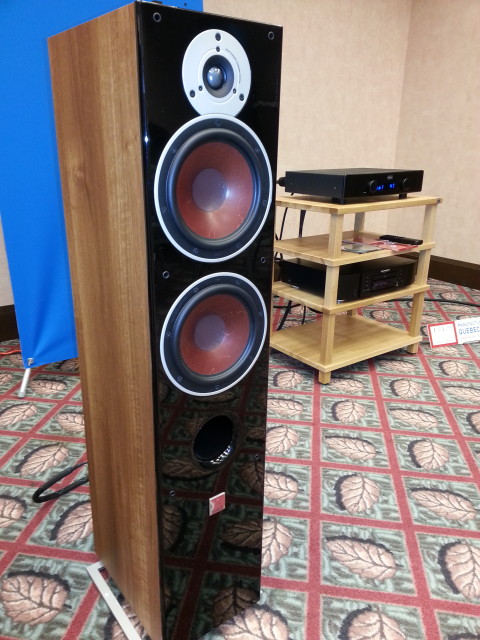
Moving to the high end of DALI’s line, the new $15,000 Epicon 6 loudspeaker was powerful, rhythmic and punchy. The drums on Elvis’ underrated performance of “Fever” were astoundingly real. You could hear the recording studio’s ambience. Lorde’s Pure Heroine was hypnotic, neurotic, narcotic. Bass and synth were punchy and elastic, but not the driest or grippiest I have heard. Jeff Buckley’s guitar shimmered under a lilac tree. The folks from Brosseau Audio run BMC amplification with the DALI Epicon. The stunning BMC CS-2 will cost you $8995. The amp has limitless supplies of energy. It is clean and musical. It also happens to be serious eye candy. Notice the Swiss timepiece motif, similar to the Dan D’Agostino amplifier look. It took German and American companies to marry Swiss wristwatch bling factor with audio amplification. Contrast this with Swiss Soulution’s Shaker Chic Motif (the Shaker sect prized asceticism over worldly displays of wealth) or Weiss’ very ordinary looking (if not sounding) DACs.

Speaking of style, I counsel you to consider these fine-sounding but finer-looking DALI speakers. They may look like ‘lifestyle’ products but they are pure hi-fi, sounding much bigger than their footprint would suggest.
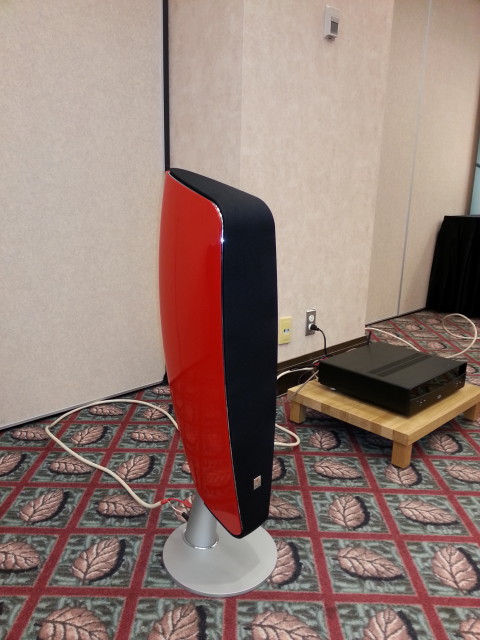
Wall of Sound “Room of the Show” Award
2. Co-Winner: Woo Audio
Woo Audio could double its prices on its top-end amps and few people would be scared away. Whether I was listening to the Audeze LCD-3 or the LCD-X, the Beyerdynamic DT990 or the T1, the Sennheiser HD800 or Abyss headphones, the sound was grain-free, big, open, and addictive. The music seemed to flow like a smooth, powerful stream. I listened to each one of the six or so Woo amps on display and was taken aback by every single one, although I did find the big 300b-based amp to be a bit too powerful for my sensitive ears.


Two discs I know very well were streaming from tablets: Lizz Wright’s “The Orchard” and Jimmy Cobb’s “Jazz in the Key of Blue.” The Woo WDS-1 DAC and CD player are also world-class at entry-level prices. And every Woo product looks like a million dollars. My favorite was the WA6 SE hooked up to Sennheiser HD 800s. Although the Audezes were probably superior sounding, I just cannot imagine wearing the heavy Audezes for long periods. With the Senns, I could forget that I had headphones on–they are so light and airy sounding and feeling. Senns have a reputation for searing highs, but not through the Woo clan of amps.

The best overall amp is probably the WA2 since it also doubles as a pre-amp and it goes for just $1199. It was magical with Audeze (although I had the dial at 1 pm, suggesting the limits of the amp with planar headphones). The WA2 was even better with the Beyerdynamic T1s, which I used to own. Perhaps I would still own them if I had purchased the WA2, which I almost did one year ago.
In a world of glittering prizes for audio bling and the endless compromises of MP3, Woo Audio restores my belief in integrity. I challenge you to find better products at these prices. How refreshing to see that the spirit of audio lives on thanks to Jack Wu and the other members of the Wu family. Based in New York, Woo Audio handcrafts some of the planet’s finest audio equipment at prices the average consumer can afford.
Wall of Sound “Best New Product” Award and “Best Mid-Priced Product”
Tri-Art “Bam Bam” loudspeakers. $4700 approx. (TBD)
Tri-Art from Ontario makes a giant-killer of a turntable, the “Pebbles,” for just $1295. The Pebbles name harkens back to the time when Tri-Art made most of its gear encased in concrete. Today, they have moved on to bamboo. This newish company held listeners spellbound with its bamboo-enclosure speakers.
This was, without doubt, one of the very best-sounding rooms at SSI. As I stayed for lengthy listening sessions, I noticed that many others did too. This room put to shame several nearby rooms in which the electronics and speakers cost five times as much. Tri-Art’s inexpensive Class D amplifiers were sounding very tube-like to me, filling the room with bloom, not boom. The sound was uber-detailed, yes, but also organic, warm, and thick, with a massive soundstage. The Bam Bam speakers employ a super-tweeter and this was readily apparent as the highs soared into the stratosphere without being shrill. Employed judiciously–consider Harbeth Super HL5s–a super tweeter can mimic a ribbon and add air and dimensionality to the sound. That’s exactly what the Bam Bam did. And Bam Bam packs bass slam, no question about it. It is a testament to the Ginsbergs’ (father and son) talents that they could crank the volume in a small space without causing room boom.
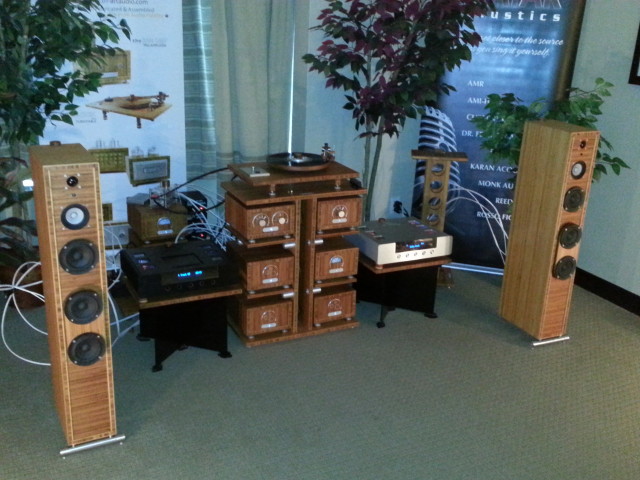
Wall of Sound “Best of Show” (cost-no-object)
Muraudio “Domain Omni ESL”. Loudspeakers. $58,000 CAN approx.
The “Best of Show” (cost-no-object) award goes to Muraudio from Ottawa, Canada. Their omni-directional electrostatic/conventional driver speakers filled a large room with a… wall of sound.
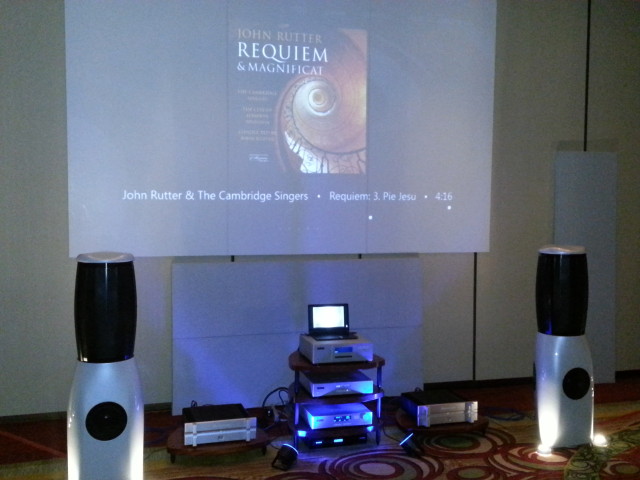
Make that a circle of sound, for these are not dipoles but omnidirectionals. Semantics aside, these sounded wonderful. These are, apparently, the world’s only omnidirectional electrostatics. They are paired with omnidirectional conventional transducers–three per speaker. Imagine a three-way marriage between Quad, MBL and Martin Logan. Design a 360 degree, cylinder-shaped electrostatic section measuring 5000 cm2 on top. And add built-in 700 watt Class D amps to power the woofers down below. Presto, a sweet spot for everyone in the room.
And then dig deep into your pockets: you’ll need more than fifty thousand dollars to hear these holler. But if you have the cash and you have the space, these are for you. Imagine a speaker that is relaxed, easy like a Sunday morning Requiem, smooth, and coherent. Remember that they really do sound just as good in a conventional sweet spot as they do from any other spot in the room. I walked from one side of a very large room to the other as the music was playing. There was no breakup. It was seamless. I was expecting the same Copperfield Effect with MBL but MBL didn’t quite get there–or, rather, they didn’t quite disappear. Perhaps because the MBLs were showing in a small room.
The Muraudio is an easy load to drive. When I asked Rob Runolfson of Muraudio to “turn it up to 11,” he kindly obliged. And he rocked the room. If MBL’s big $200k speakers are for for the top 0.1%, then Muraudio is for the top 1%. Let’s hope that Muraudio thrives and its technology trickles down to the top 10% and lower still.
Best Headphones of the Show: Stax and Audeze
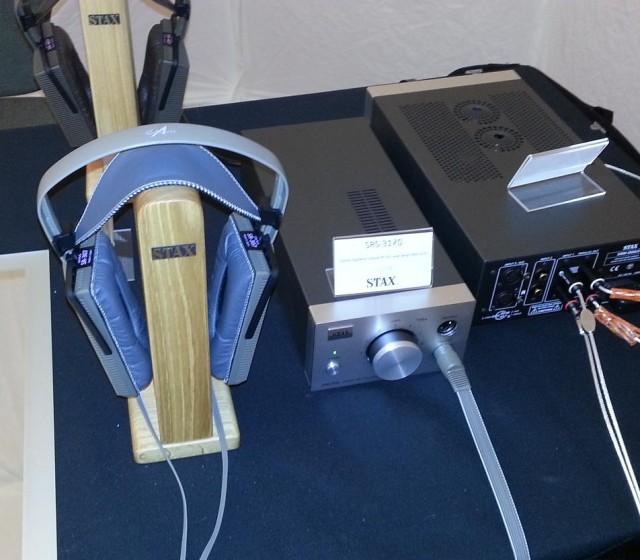
Both the Stax and Audeze headphones on display were stunning. Stax had a display tent (literally) in which four of their headphones–each with a required, dedicated Stax amp–were playing the same tune. With a Stax electrostatic system, either you’re all in, or you’re out. Count me in.
One could literally do an a/b/c/d comparison. Going from Stax’s $1500 system to its $5k system was like going from the second wine of a great Left Bank estate like Latour or Léoville to the grand vin. Both are outstanding, but the more expensive one delivers just that little extra oomph and richness. Stax headphones share a house style: clear, open, transparent, slightly forward, detailed, but not thin nor edgy. Dynamics are effortless. With my limited experience with Stax, I cannot confidently say that they are the best headphones in the world, but I can see why some people believe they are. At this level of quality, it comes down to taste. I see Stax as the Simaudio of headphones. Think 20/20 vision. Stax unveils the music, warts and all. Strings will shine like a National guitar. Detail freaks take note. The detail does not, however, come at the expense of musicality.
Audeze is more of a dobro with tonewood sort of sound. Audeze lets you see the music through a glass, but darkly. Think warm tubes. The LCD-3 and LCD-X were paired brilliantly with Woo amplification and sources. They were smooth. Whether it was AC/DC or classical guitar, they sounded exquisite. Saturated tonal colors.
I listened to the top of the line Grados, which were, as one would expect, light, open, airy, and on the bright/detailed side. If that’s your cup of tea, drink up. I prefer a darker, richer brew. Having said that, Grado makes, without doubt, the world’s best sub $200 headphones. The budget headphone award would probably go to the Grado SR-60i, hooked up to the Micromega MyDac. Hard to beat at the combined price of just under $550.
And while we are on the topic of bon rapport qualité prix, Victor Kung of VK Music, British Columbia, has just launched the new Japanese Elekit TU-8200 DX single-ended amplifier ($725). It sounded great with VK’s wood-cone single driver speakers. It was Friday morning at 10 am, one hour before the show was scheduled to begin. As I was leaving the Hilton’s restaurant I thought I heard a singer coming from the exhibition level, below, down the escalators. In fact, it was a CD recording of the artist Youn Sun Nah playing through the Elekit. Victor was using the amazing Psvane gray bottle KT88 tubes. The amp also takes 6550, EL34, and the 6L6 family. Driver tubes are 12au7. The TU-8200 DX can put out about 8 watts, but these are real tube watts backed by some serious iron–the small amp weighs 15 pounds.
The Elekit also happens to also be a world-class headphone amplifier. Victor Kung was demoing it with Sennheiser HD 650s. It seemed just as musical as a Woo amp. The soundstage was massive. For $725, can there be a better amp/headphone amp? Musical Paradise’s MP-301 MK3 would compete, but the headphone section on the Elekit is probably quieter.
Victor sells a wide variety of DIY kits, from amps to small DACs. Prices are sane and build quality of parts is top notch. An accountant by day, Victor’s moonlighting desires constitute some sort of public service to audiophiles around the world, providing world-class sound at affordable prices. He tells me it takes him about four hours to make the TU-8200 DX. If you are not experienced with soldering, budget for eight hours. This is still far less work than a Bottlehead Crack, which took me 25 hours to make.
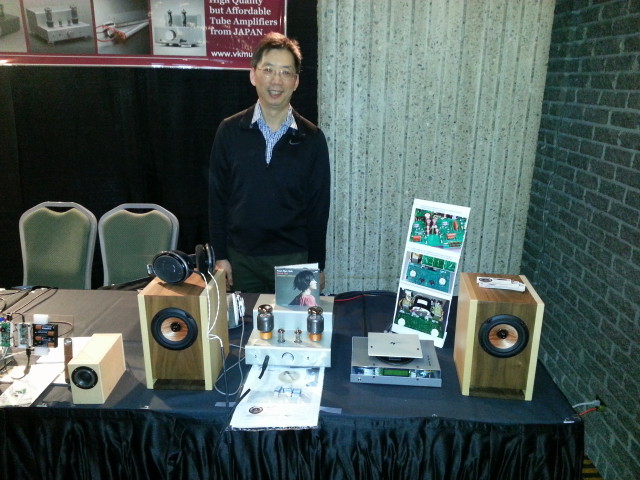
Steven Huang’s Toronto-based company, Audio Sensibility, is another Canadian player punching far above its price points. Steven has a B.Sc in Chemical Engineering and an M.Sc in Mechanical Engineering. He has a good grounding in metallurgy. His power conditioners, power cables, speaker cables, headphone cables and interconnects have the fit and finish of pricy gear but he puts his products onto market at prices the average hoser can afford.
Steven uses Ohno Continuous Casting copper wire and big brand connectors like Furutech. Steven makes no attempt to blind his prospective customers with pseudo-science. Rather, he invites you to sample his technology. Steven offered me a Pepsi challenge of sorts: he had two identical headphones connected via a router switch to an iPad. One headphone came with its stock cable; the other, with an Audio Sensibility cable. The difference was as clear as night and day. I was sold on the spot. The soundstage opened up, bass was firmer, and everything was clear with less grain. The sound was simply ‘bigger’ in every way. On the basis of this taste test, I asked for a sample of his upgrade cable for the HiFiMan HE-400. Stay tuned to www.wallofsound.ca for my review of this cable. Having already listened to several discs, I can say with confidence that my HiFiMans sound dramatically more dynamic.
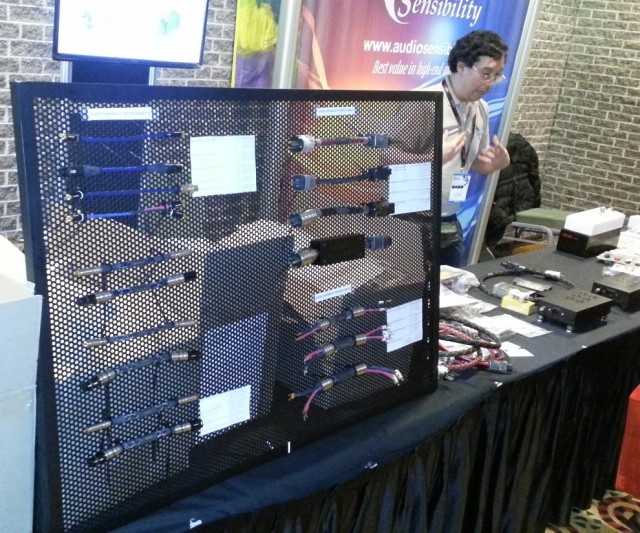
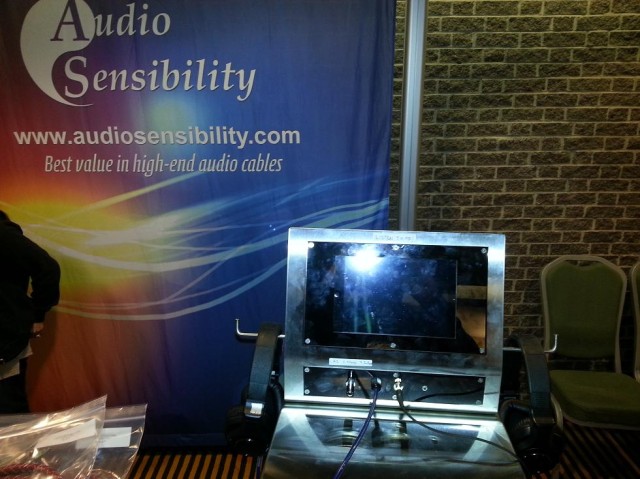
BC Acoustique from France/China demo’d some of the best sub $5,000 systems. The sound was big and warm, slightly euphonic, slightly thick, and not the quickest draw in the shootout. But oh so pleasant. One of my favorite LPs, “The Jimmy Giuffre 3” was spinning. The BC Acoustique Act A2.1 at $2298 floorstanders are highly recommended. They filled a large room with deep bass.
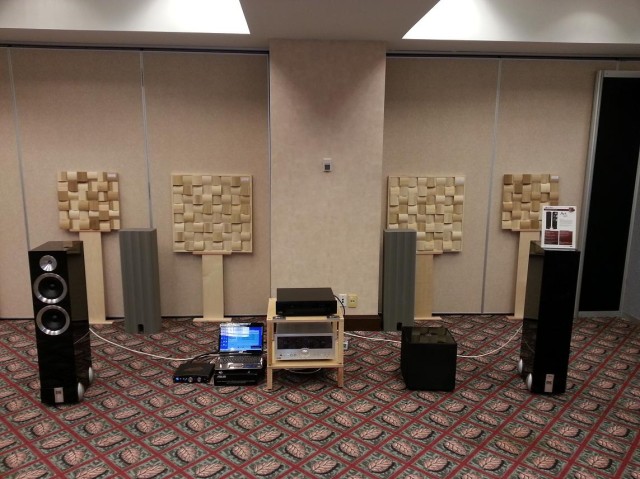
Resonessence Labs from British Columbia showed that it is producing world-class DACs at real-world prices. I visited their room four times and heard two of their DACs, including the $599 Concero and the $4995 Mirus. Frankly the $599 DAC sounded almost as good as the reference level product. Well, perhaps 85% as good? But that’s saying a lot. Both sounded smooth, musical, with not a trace of digititis. The Mirus sounded more powerful and punchy, with deeper bass. These DACs are organic, balanced, coherent. Charlie Musselwhite’s harmonica on “Rank Strangers to Me” was not too bright, just right. Bass was not overly dry, nor was it bloated. The room was perfectly dialed in. This was all the more impressive since Resonessence was showing their DACs with “old lower-mid level B&W speakers we bought on Ebay for $500”.
Resonessence did not want listeners to wonder if they were hearing the DAC or a pair of great speakers, so they elected to go with a very average speaker. Amplification was a Resonessence prototype. And yet it worked. Apart from a couple of systems based on Esoteric CD/SACD players, this was, to my ears, the best digital sound of the show. Certainly it was the best affordable sound.
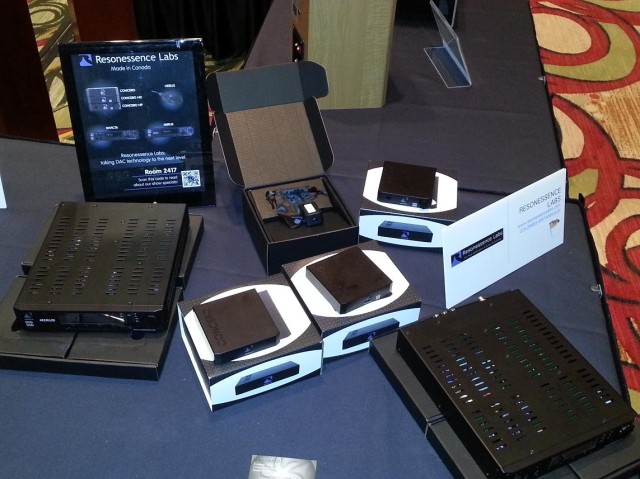
April Music showed their amps and DACs, including the Stello S-100 and the HP-100, in a large room. All the female vocalist chestnuts were cracked open–Eva Cassidy, Norah Jones, Holly Cole. In general the sound was wonderful and surprisingly big. If you want smooth sounding audio with elegant style, April Music is for you. There was a tiny bit of sibilance at times, but I cannot say for sure if this was the electronics, or the mid-level Quad speakers’ fault. Or the cables?

I am inclined to think it was the Quads, since I noted the same sibilance when the Burson Timekeeper mono block amps and Conductor DAC/preamp were hooked to Quads. Having owned a Burson DAC/preamp/head-amp, I know it is not bright kit. The Burson Audio products generally sounded warm, dynamic and punchy. I was pleased to see that the Burson stepped attenuator no longer seems to click loudly, as the first few production runs did. When I touched the volume knob, however, I was electric and the Burson was electric too (like static cling). The same thing used to happen with my old Burson. These minor flaws aside, Burson gear is sleek, compact eye candy, and something of a bargain, just like the April Music gear. With certain music, Burson gear sounds as good as $10,000 gear, but it costs just one-tenth to one-fifth that amount. Burson’s small footprint is deceptive; under the hood there lurks one mean, punchy luchadora. Burson’s designers come from a land down under but their gear is made in parts unknown. This is kit of the highest build standards.

There’s no question about the provenance of Devialet. It was hatched, its parts are matched, and it’s dispatched from the Republic of France. Devialet likes the all-in-one and indivisible approach. It saw an opening for a ‘lifestyle’-like product that simplified and sounded as good as it looked. If you wish to dispense, once and for all, with the maddening crowd of interconnects that plagues most of our houses, look at Devialet. I listened on three occasions to the Devialet 110 ($7000) paired with the Focal 926 speaker ($3700). The sound was Naim-like, yes, but smoother, more organic. (Nothing against Naim–I love their stuff and once owned it). The Devialet was dynamic with loads of PrAT but seemingly restrained at the highest frequencies–could that be the Class A input stage? In any case, very sweet. I think you can get sound of this quality for a couple thousand dollars less. What you cannot get is the convenience of having everything from DAC to pre to power to streamer to phono pre to can opener (etc., etc.) in one box. Nor can you get the stunning looks of Devialet for less. Image–as Agassi said–is everything. There’s but one proviso: you can have your Devialet in any colour as long as it’s silver.
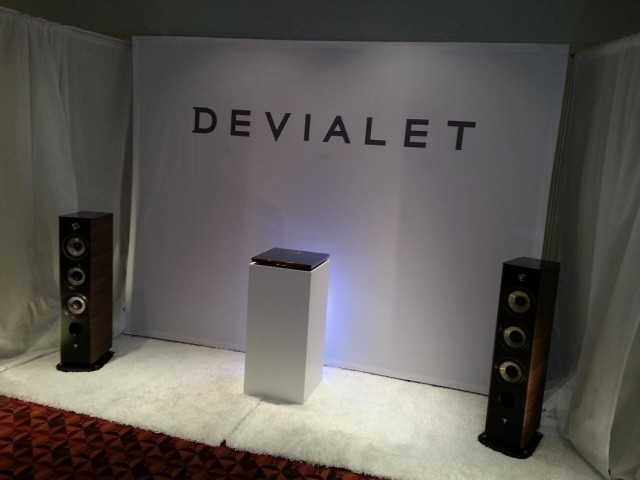
The ‘Thrill Ain’t Gone’ Award
The French were on something of a winning streak in Montreal. Consider Focal. Near the top end of the Show’s offerings, Audiophile Experts put together a system comprising Focal’s Scala Utopia 2 ($35,000 CAN), Linar amplifiers from Ottawa, Ontario, and sources from Japan’s Esoteric, including their rubidium clock. It was mesmerizing, breathtaking. It was visceral and majestic but never bright or fatiguing. It literally rocked the house. People were tapping their toes, as if at a concert.
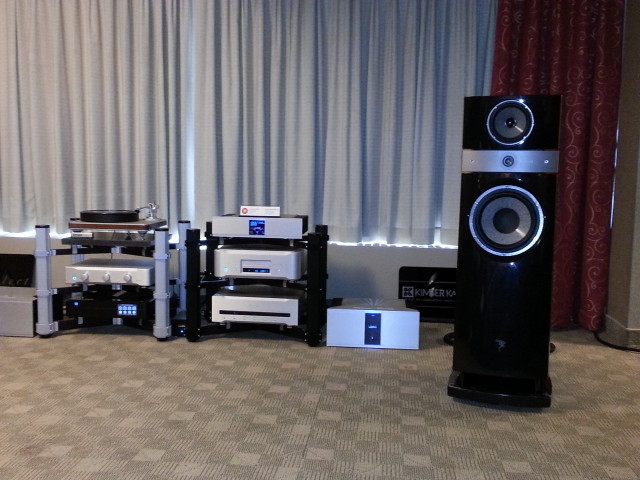
And so the thrill of the show award goes, without doubt, to the Audiophile Experts room. This was one of the few rooms in which a $50k to $100k system sounded utterly outstanding. OCD-afflicted audiophiles and their nattering neophyte spouses alike were mesmerized. The visceral punch and rhythmic drive was spellbinding, whether Supertramp’s “School” or the (over-played) Dead Can Dance was playing. I visited this room several times and rarely did people get up and leave in the middle of a song–as they did in several rooms with gear valued over $100,000, or even $400,000. The Focals delivered me back to an August 1983 night at the Montreal Forum, the first and last time I saw Supertramp live. The 11 inch woofers conveyed a sense of limitless energy but even as they sent vibrations down my spine, I could easily locate all the other instruments. Everything in its place, and a place for everything.
With the notable exception of Focal, two speaker producers from Canada stole the show from the big names. Muraudio, featured above in this Show Report, and Samaudio from Quebec (no relation to Simaudio). A Samaudio system including two subwoofers was powered by Gilbert Yeung’s wonderful Blue Circle amps. Louis Armstrong was in the room, but without his usual companion, tape hiss. One could easily locate the trumpet, trombone and clarinet as they played the same notes. This was among the most musical systems at the show. Again, the asking price (around $50k for the system) seemed reasonable for this level of quality. You may not have heard of Samaudio, but you will soon. This new company strutted its stuff in a dark room but it has a bright future.
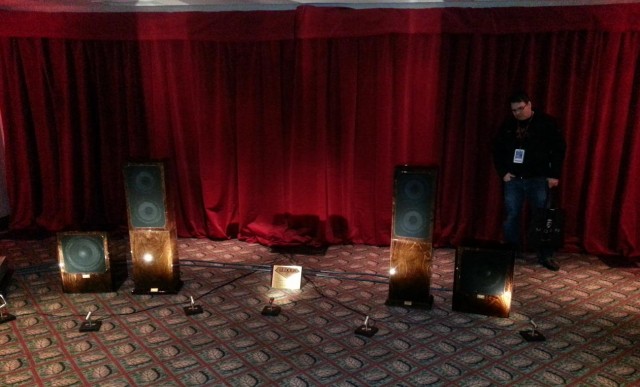
My-my-my-my Corona. MBL feels the pain of the trader
You’ve heard of MBL, and MBL is starting to listen to you. Well, to some of you, perhaps. MBL hears the top 1% cry ‘what about us’? The Corona line is designed to share MBL’s wealth of engineering prowess with the mere traders, not just the hedge fund managers who buy the $200,000 speakers made by the decorated German firm. The Corona line on display featured the 300 watt per channel C21 stereo amp with LASA technology (Linear Analog Switching Amplifier), MBL’s take on switch-mode output stages. It retails for $9,200. It was paired with the C11 preamp, retailing for $8,800. The DAC/CD player was the C31, which retails for $9,200. It accepts up to 24/96 data on asynchronous USB, S/Pdif, or TosLink digital inputs. All signals are up sampled to over 5 MHz internally. The loudspeaker was the smallest floor standing Radialstrahler, featuring the same radial tweeter and midrange as all of MBL’s other speakers (it’s a four way design). It retails from $29,000. So, a little under $60k for more than a slice of MBL’s top technology. It sounded simply sublime as I walked the line down the main corridor. It was Thursday and MBL was just setting up. It was one of those ‘is it live or is it Memorex’ moments. I thought some cheese-doodle easy-listening flamenco guitarist might be playing. Actually it was the MBLs.
The ever-inventive audio genius Taras Kowalczyszyn of Teo Audio (of the gallium-filled liquid interconnects) was helping to set up his prototype aluminum rack. Mercifully, the next tunes were by Roxy Music (Avalon) and Wings (Band on the Run). The sound was open, spacy, airy, and balanced from top to bottom end. To cap it all off, Rush’s “Tom Sawyer” was played. Yes!
Critics of audio bling sling blades and launch arrows at MBL. What they say about this company, is what they say about society. Well, they should, in the words of René Lévesque, take a valium–and then sit back and listen to the Corona line. I came back to the room half a dozen times. When some jazz band’s rendition of “Walking on the Moon” was played on Friday (it wasn’t the Christian McBride version), I was sold. The Corona line is worth every dime. These are fast speakers! They are works of art. They didn’t quite perform the magic of the Copperfield Effect, but MBL needs a bigger room in which to disappear.
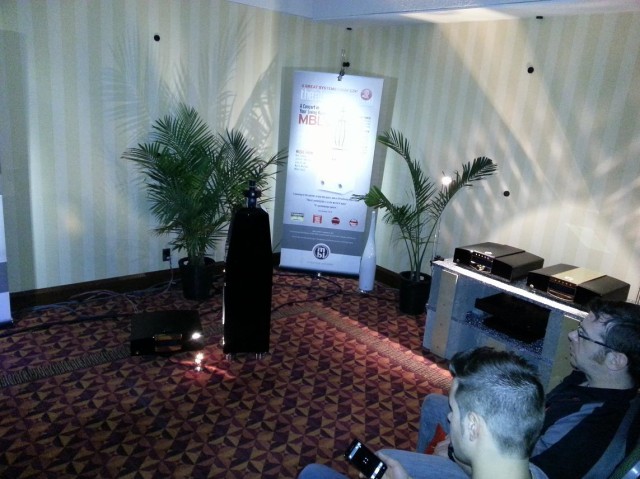
The same is true, I think, of another seriously sexy speaker, the Vivid Giya 3. The genial Philip O’Hanlon, distributor for Luxman, Vivid and other top brands, presided over one of Coup de Foudre’s three brilliant-sounding rooms (Coup de Foudre is a leading Montreal hifi store). The music selection was sublime, the Luxman electronics were fine, but some people came, it seems, for a showing of Vivid’s audio porn. No other speaker at SSI garnered so much attention for its fine figure.
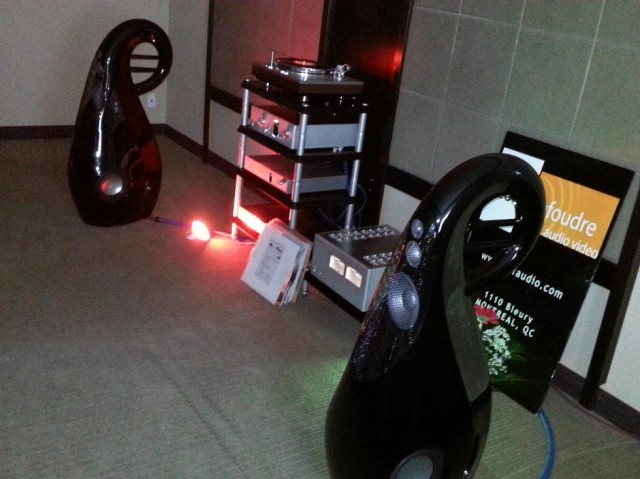
Laurence Dickie’s big Vivid loudspeakers are superlative works of art. But let’s not judge this speaker by its curvaceous cover: how about its sonic personality? Easy. Smooth and natural. No enhancements, electronic or otherwise. No artifice. Like music. My foolish request to ‘turn it to 11’ was tactfully rebutted by Mr. O’Hanlon, who pled poverty of room space. One wonders to what extent we were teased by Vivid in such a small room. Mr. O’Hanlon can be forgiven for succumbing to the temptations of Bosendorfer but failing to mention Fazioli as the greatest piano ever made…well…my forgiveness knows certain boundaries. Having heard these speakers in a larger venue, I know they are great, among the world’s best. But as with the MBLs and the big Harbeth 40.1s, they needed a bigger room.
Continuing with the theme of audio objets d’art, Lawrence Audio’s gorgeous speakers are nonpareil. But each time I entered this room, I heard the same things play: piano sonatas by Chopin and Beethoven. Chopin and Beethoven. The Lawrences sounded very nice, but you’ll buy these for their good looks.
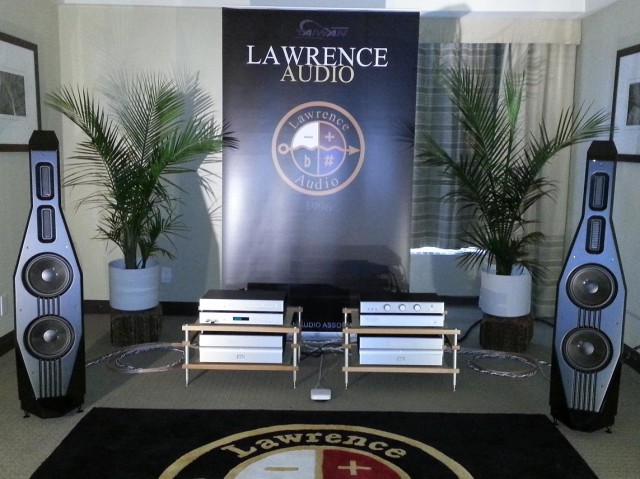
The same would be true of Cabasse. Paired with McIntosh, the Cabasse orbs sounded wonderful. They disappeared like panel speakers. “Papa was a Rolling Stone” was playing. Nice sound, great looks, high price. But the need for a big ugly subwoofer (Cabasse doesn’t pack much back) kind of negates the goal of creating a small, attractive footprint, don’t it?
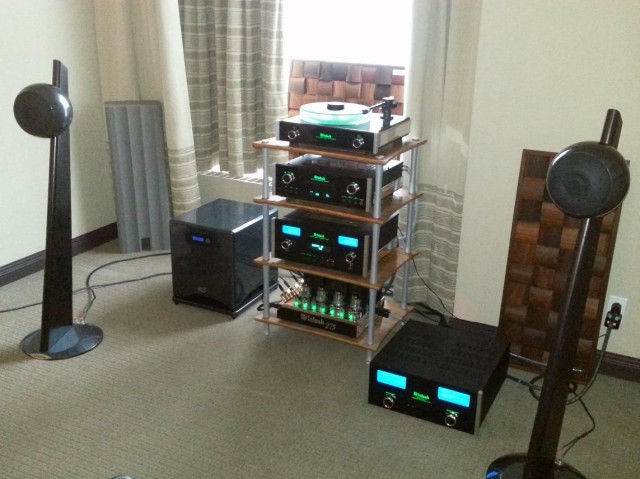
I like the stark, porcelain-like beauty of the new Raidho mini monitors’ woofers. They are otherworldly bright–like Jack Schmidt’s space suit in that famous photo taken of him saluting the stars and stripes on the moon in 1972, as he and Gene Cernan were about to depart Taurus Littrow. The Raidhos sound great but they don’t come with a down-to-earth price tag. Eight thousand dollars to be precise. Raidho was powered by Jeff Rowland’s amazing Continuum amp, helping it to produce some of the best bass in the show. Yes, it takes two to tango, and the diminutive Raidho could keep step with Rowland’s stunning masterpiece. The sound was so very taut and dry, so very dynamic. I think the speakers were being driven to their limits and perhaps the music was chosen to highlight the amazing quality of the bass. Is this little speaker too good to be true? At times–I visited this room at least six times–I thought this was some of the best sound at the Show. And I mean the full spectrum, high to low.
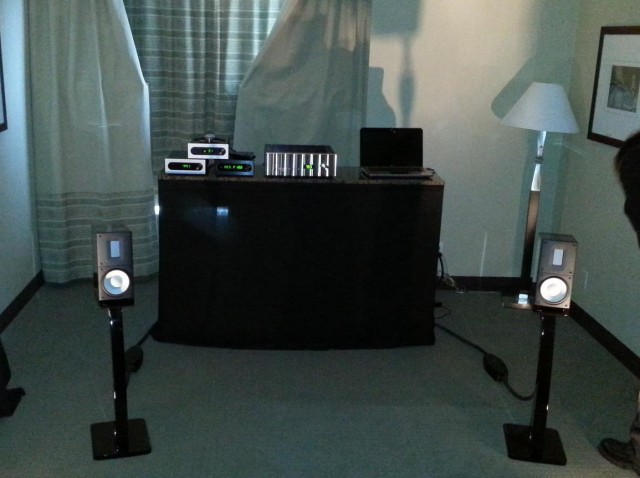
For the same coin, consider the wonderful Toronto-based Gershman Acoustics’ Avant Garde R-1 ($8000). These are seriously good looking speakers. The bass was, likewise, among the very best of the show. I listened to these speakers on four or five occasions. Solo cello was rendered with a timbral accuracy unparalleled at the Show. These are powerful, detailed, forward, dynamic speakers that don’t need too much juice to come alive (just 40 watts will do). They go down to a claimed 24Hz. Source and amplification were from Audia Flight. (I wonder how tubes would mate with Gershman?) Church organ was thunderously low and guitars were shimmering, vibrant. Fabulous!, say my notes from the Show. The bottom-heavy design means that toddlers will have a difficult time toppling these 75 pound beasts. Gershman was also showing its new isolation devices employing magnets.
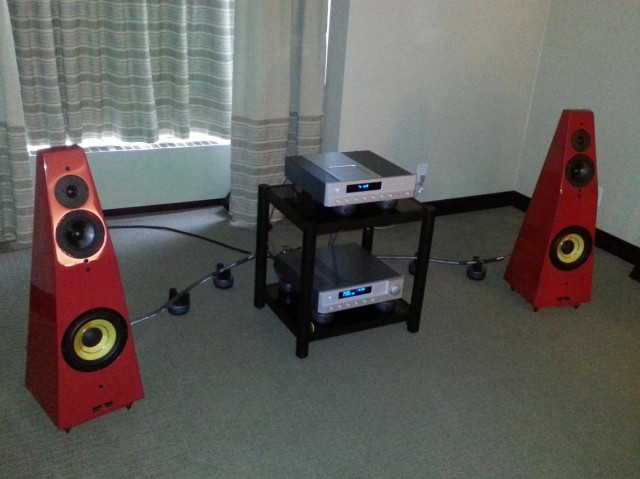
And with this I conclude the Show report. As I said in the opening, I visited almost every room (I could never find the time to get into Sony’s popular room). These are the products that stood out as being particularly interesting and/or a good value. Hope to be back next year!
[views]

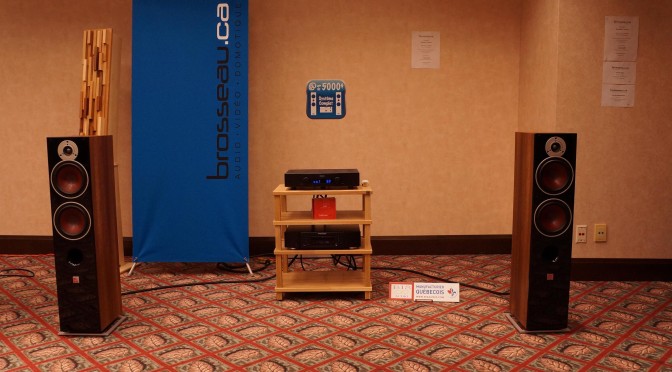
Congratulations, Tim. Absolutely stellar job on the SSI Show!